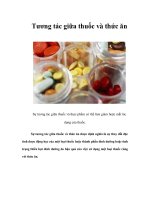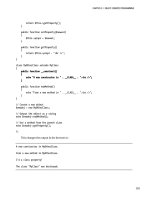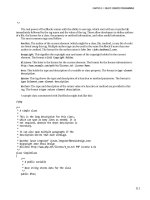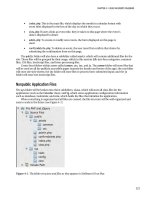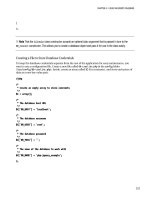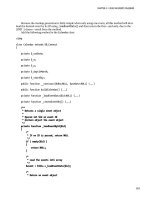Tương tác giữa PHP và jQuery - part 21 pptx
Bạn đang xem bản rút gọn của tài liệu. Xem và tải ngay bản đầy đủ của tài liệu tại đây (484.79 KB, 10 trang )
CHAPTER 6 ■ PASSWORD PROTECTION SENSITIVE ACTIONS AND AREAS
201
<div id="content">
<form action="assets/inc/process.inc.php" method="post">
<fieldset>
<legend>Please Log In</legend>
<label for="uname">Username</label>
<input type="text" name="uname"
id="uname" value="" />
<label for="pword">Password</label>
<input type="password" name="pword"
id="pword" value="" />
<input type="hidden" name="token"
value="<?php echo $_SESSION['token']; ?>" />
<input type="hidden" name="action"
value="user_login" />
<input type="submit" name="login_submit"
value="Log In" />
or <a href="./">cancel</a>
</fieldset>
</form>
</div><! end #content >
<?php
/*
* Output the footer
*/
include_once 'assets/common/footer.inc.php';
?>
Save this code and navigate to http://localhost/login.php in your browser to see the resulting
login form (see Figure 6-2).
Figure 6-2. The login form
CHAPTER 6 ■ PASSWORD PROTECTION SENSITIVE ACTIONS AND AREAS
202
Creating the Admin Class
With your table in place, you can now start structuring the class that will interact with it. In the class
folder, create a new file called class.admin.inc.php (/sys/class/class.admin.inc.php). This class will
contain methods to allow users to log in and log out.
Defining the Class
First, you define the class, which will extend DB_Connect in order to have database access. This class will
have one private property, $_saltLength, which you’ll learn about a little later in this section.
The constructor will call the parent constructor to ensure a database object exists, and then it will
check whether an integer was passed as the constructor’s second argument. If so, the integer is used as
the value of $_saltLength.
Now insert the following code into class.admin.inc.php to define the class, the property, and the
constructor:
<?php
/**
* Manages administrative actions
*
* PHP version 5
*
* LICENSE: This source file is subject to the MIT License, available
* at
*
* @author Jason Lengstorf <>
* @copyright 2010 Ennui Design
* @license
*/
class Admin extends DB_Connect
{
/**
* Determines the length of the salt to use in hashed passwords
*
* @var int the length of the password salt to use
*/
private $_saltLength = 7;
/**
* Stores or creates a DB object and sets the salt length
*
* @param object $db a database object
* @param int $saltLength length for the password hash
*/
public function __construct($db=NULL, $saltLength=NULL)
{
parent::__construct($db);
CHAPTER 6 ■ PASSWORD PROTECTION SENSITIVE ACTIONS AND AREAS
203
/*
* If an int was passed, set the length of the salt
*/
if ( is_int($saltLength) )
{
$this->_saltLength = $saltLength;
}
}
}
?>
Building a Method to Check the Login Credentials
The data from login.php needs to be validated in order to verify that a user is authorized to make
changes to the events table. You can follow these steps to accomplish this:
1. Verify that the form was submitted using the proper action.
2. Sanitize the user input with htmlentities().
3. Retrieve user data that has a matching username from the database.
4. Store the user information in a variable, $user, and make sure it isn’t empty.
5. Generate a salted hash from the user-supplied password and the password
stored in the database.
6. Make sure the hashes match.
7. Store user data in the current session using an array and return TRUE.
■ Note Salted hashes will be covered in the next section, “Build a Method to Create Salted Hashes.”
Start by defining the method in the Admin class and completing the preceding Steps 1 and 2 using
the following bold code:
<?php
class Admin extends DB_Connect
{
private $_saltLength = 7;
public function __construct($db=NULL, $saltLength=NULL) { }
/**
CHAPTER 6 ■ PASSWORD PROTECTION SENSITIVE ACTIONS AND AREAS
204
* Checks login credentials for a valid user
*
* @return mixed TRUE on success, message on error
*/
public function processLoginForm()
{
/*
* Fails if the proper action was not submitted
*/
if ( $_POST['action']!='user_login' )
{
return "Invalid action supplied for processLoginForm.";
}
/*
* Escapes the user input for security
*/
$uname = htmlentities($_POST['uname'], ENT_QUOTES);
$pword = htmlentities($_POST['pword'], ENT_QUOTES);
// finish processing
}
}
?>
Next, complete Steps 3 and 4 by adding the following code shown in bold:
public function processLoginForm()
{
/*
* Fails if the proper action was not submitted
*/
if ( $_POST['action']!='user_login' )
{
return "Invalid action supplied for processLoginForm.";
}
/*
* Escapes the user input for security
*/
$uname = htmlentities($_POST['uname'], ENT_QUOTES);
$pword = htmlentities($_POST['pword'], ENT_QUOTES);
/*
* Retrieves the matching info from the DB if it exists
*/
$sql = "SELECT
`user_id`, `user_name`, `user_email`, `user_pass`
FROM `users`
CHAPTER 6 ■ PASSWORD PROTECTION SENSITIVE ACTIONS AND AREAS
205
WHERE
`user_name` = :uname
LIMIT 1";
try
{
$stmt = $this->db->prepare($sql);
$stmt->bindParam(':uname', $uname, PDO::PARAM_STR);
$stmt->execute();
$user = array_shift($stmt->fetchAll());
$stmt->closeCursor();
}
catch ( Exception $e )
{
die ( $e->getMessage() );
}
/*
* Fails if username doesn't match a DB entry
*/
if ( !isset($user) )
{
return "Your username or password is invalid.";
}
// finish processing
}
Now the user’s data is stored in the variable $user (or the method failed because no match was
found for the supplied username in the users table).
Finishing Steps 5-7 completes the method; do this by adding the following bold code:
public function processLoginForm()
{
/*
* Fails if the proper action was not submitted
*/
if ( $_POST['action']!='user_login' )
{
return "Invalid action supplied for processLoginForm.";
}
/*
* Escapes the user input for security
*/
$uname = htmlentities($_POST['uname'], ENT_QUOTES);
$pword = htmlentities($_POST['pword'], ENT_QUOTES);
/*
* Retrieves the matching info from the DB if it exists
*/
$sql = "SELECT
CHAPTER 6 ■ PASSWORD PROTECTION SENSITIVE ACTIONS AND AREAS
206
`user_id`, `user_name`, `user_email`, `user_pass`
FROM `users`
WHERE
`user_name` = :uname
LIMIT 1";
try
{
$stmt = $this->db->prepare($sql);
$stmt->bindParam(':uname', $uname, PDO::PARAM_STR);
$stmt->execute();
$user = array_shift($stmt->fetchAll());
$stmt->closeCursor();
}
catch ( Exception $e )
{
die ( $e->getMessage() );
}
/*
* Fails if username doesn't match a DB entry
*/
if ( !isset($user) )
{
return "No user found with that ID.";
}
/*
* Get the hash of the user-supplied password
*/
$hash = $this->_getSaltedHash($pword, $user['user_pass']);
/*
* Checks if the hashed password matches the stored hash
*/
if ( $user['user_pass']==$hash )
{
/*
* Stores user info in the session as an array
*/
$_SESSION['user'] = array(
'id' => $user['user_id'],
'name' => $user['user_name'],
'email' => $user['user_email']
);
return TRUE;
}
/*
* Fails if the passwords don't match
*/
CHAPTER 6 ■ PASSWORD PROTECTION SENSITIVE ACTIONS AND AREAS
207
else
{
return "Your username or password is invalid.";
}
}
This method will now validate a login form submission. However, it doesn’t work just quite yet; first,
you need to build the _getSaltedHash() method.
Building a Method to Create Salted Hashes
In order to validate a user’s password hash stored in the database, you need a function to generate a
salted hash from the user’s supplied password (a hash is an encrypted string generated by a security
algorithm such as MD5 or SHA1).
■ Note For more information on password hashing and security algorithms, visit
INCREASING SECURITY WITH SALTED PASSWORDS
Even though PHP provides functions to hash, or encrypt, strings, you should use additional security
measures to ensure that your information is entirely secure. One of the simplest and most effective ways
to heighten security is through the use of salts, which are additional strings used when hashing
passwords.
Using Rainbow Tables and Common Encryption Algorithms
Common encryptions algorithms, such as SHA1 and MD5, have been fully mapped using rainbow tables
1
,
which are reverse lookup tables for password hashes. In a nutshell, a rainbow table allows an attacker to
search for the hash produced by a given encryption algorithm in a large table that contains every possible
hash and a value that will produce that hash.
Rainbow tables have been generated for MD5 and SHA1, so it's possible for an attacker to crack your
users' passwords with relative ease if no extra security measures are taken.
1
CHAPTER 6 ■ PASSWORD PROTECTION SENSITIVE ACTIONS AND AREAS
208
Improving Security with Salted Hashes
While not bulletproof, adding a salt to your hashing algorithm will make cracking your users' passwords
much more cumbersome for attackers. A salt is a string, either predefined or random, that is used in
addition to the user input when hashing.
Without using a salt, a password may be hashed like this:
$hash = sha1($password);
To add a random salt to the preceding hash, you could apply the following this code to it:
$salt = substr(md5(time()), 0, 7); // create a random salt
$hash = $salt . sha1($salt . $password);
The preceding code generates a random seven-digit salt. The salt is prepended to the password string
before hashing; this means that even if two users have the same password, their individual password
hashes will be different.
However, in order to reproduce that hash, the salt needs to be available. For this reason, the salt is also
prepended, unencrypted, to the hash. This way, when a user signs in, you’re able to extract the salt from
the hash when it’s retrieved from the database and use it to recreate the salted hash of the user’s
password:
$salt = substr($dbhash, 0, 7); // extract salt from stored hash
$hash = $salt . sha1($salt . $_POST['password']);
if ( $dbhash==$hash )
{
echo "Match!";
}
else
{
echo "No match.";
}
Incorporating Salted Hashes and Rainbow Tables
By adding a salt, rainbow tables are rendered useless. A new table will need to be generated taking the
salt into account in order to crack user passwords; while this isn’t impossible, it’s time-consuming for the
attacker and adds an extra layer of security to your app.
In most applications (especially those that don’t store much in the way of sensitive personal information
such as credit card information), a salted password is deterrent enough to ward off potential attackers.
As an additional countermeasure, it is also advisable to add a check for repeated failed attempts to log in.
This way, an attacker has a finite number of attempts to crack a password before being locked out of the
system. This can also prevent denial of service attacks, or attacks in which a huge volume of requests
are sent in an attempt to overload a site and take it offline.
CHAPTER 6 ■ PASSWORD PROTECTION SENSITIVE ACTIONS AND AREAS
209
Creating this function is relatively straightforward, requiring only a few steps:
1. Check whether a salt was supplied; if not, generate a new salt by hashing the
current UNIX timestamp, and then take a substring of the returned value at the
length specified in $_saltLength and store it as $salt.
2. Otherwise, take a substring of the supplied salted hash from the database at
the length specified in $_saltLength and store it as $salt.
3. Prepend the salt to the hash of the salt and the password, and return the new
string.
Complete all three steps by inserting the following method into the Admin class:
<?php
class Admin extends DB_Connect
{
private $_saltLength = 7;
public function __construct($db=NULL, $saltLength=NULL) { }
public function processLoginForm() { }
/**
* Generates a salted hash of a supplied string
*
* @param string $string to be hashed
* @param string $salt extract the hash from here
* @return string the salted hash
*/
private function _getSaltedHash($string, $salt=NULL)
{
/*
* Generate a salt if no salt is passed
*/
if ( $salt==NULL )
{
$salt = substr(md5(time()), 0, $this->_saltLength);
}
/*
* Extract the salt from the string if one is passed
*/
else
{
$salt = substr($salt, 0, $this->_saltLength);
}
/*
CHAPTER 6 ■ PASSWORD PROTECTION SENSITIVE ACTIONS AND AREAS
210
* Add the salt to the hash and return it
*/
return $salt . sha1($salt . $string);
}
}
?>
Creating a Test Method for Salted Hashes
To see how salted hashes work, create a quick test method for _getSaltedHash() called
testSaltedHash(). This will be a public function that calls and outputs the values, enabling you to see
how the script functions.
In the Admin class, define the testSaltedHash() method:
<?php
class Admin extends DB_Connect
{
private $_saltLength = 7;
public function __construct($db=NULL, $saltLength=NULL) { }
public function processLoginForm() { }
private function _getSaltedHash($string, $salt=NULL) { }
public function testSaltedHash($string, $salt=NULL)
{
return $this->_getSaltedHash($string, $salt);
}
}
?>
Next, add a new file called test.php to use this function and place it in the public folder
(/public/test.php). Inside this function, call the initialization file, create a new Admin class, and output
three hashes of this word: test. Create the first hash with no salt, and then sleep for one second to get a
new timestamp. Create the second hash with no salt, and then sleep for another second. Finally, create
the third hash using the salt from the second hash. Insert the following code to accomplish this test:
<?php
// Include necessary files
include_once ' /sys/core/init.inc.php';
// Load the admin object

